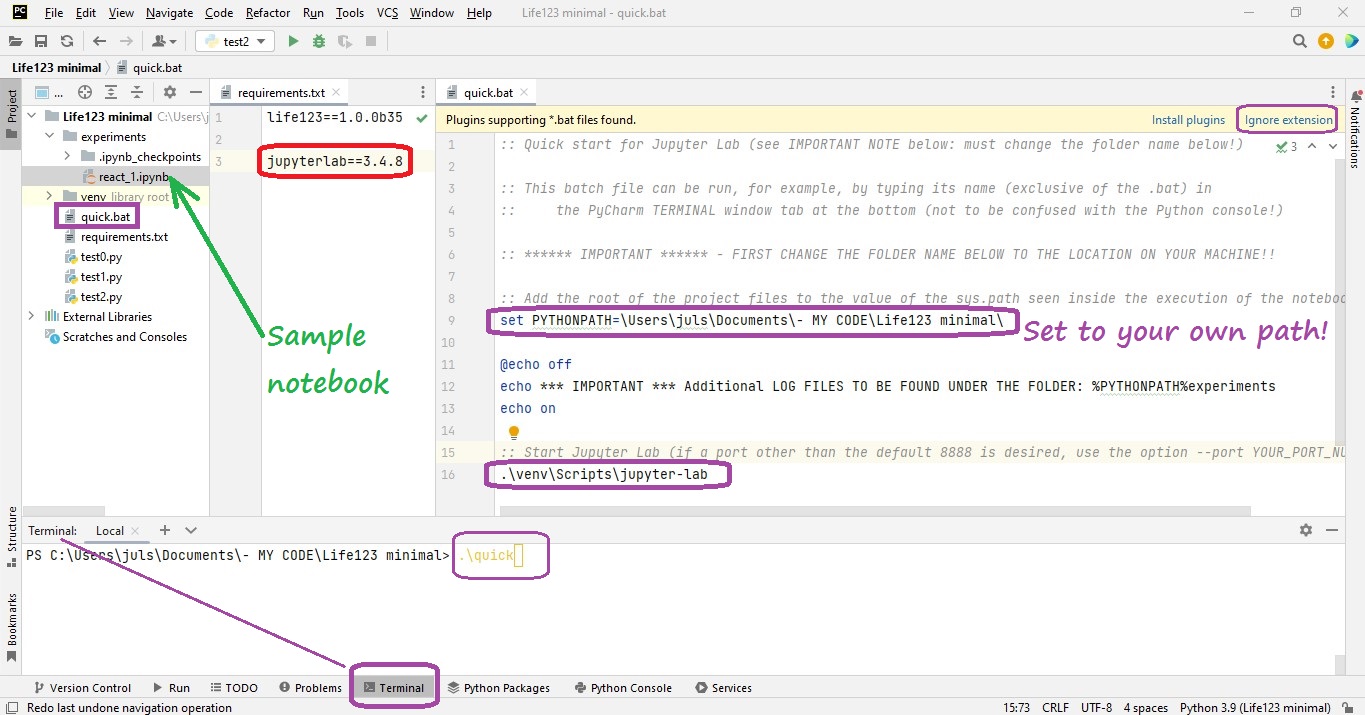Download / Install
METHOD 1 — For most users:
QUICK-AND-EASY method to run the life123 libraries locally
In brief: use pip install life123 , for example on Colab or on your IDE (such as PyCharm, etc),
then download some Jupyter notebooks from the repository (look for the ipynb file suffix), and run/modify them as you please!
(Assuming you have JupyterLab installed.)
Don't like notebooks? No problem – you can simply download and use their python-file .py versions, also provided in the same repository pages, above.
MINIMALIST EXAMPLE (NO plots and NO notebooks) using an IDE:
Use your favorite IDE (we tried PyCharm 2022.3 on Win 10/11):
- Start a new project, with a new environment using "virtualenv" and a base intepreter using Python 3.8 or higher (if Python isn't found on your device, PyCharm can install it for you)
- At the project's top level, create a new file named
requirements.txt - Inside that file, place the line
life123==1.0.0b39(CHANGE version number as needed; see changelog) - Pycharm will show a link to "Install requirement" : click on it, and wait for install to complete (dependencies, such as NumPy and plotly, are automatically installed as well)
- At the project's top level, create a new pyhon file, with the line
import life123and the lineprint(life123.__version__) - Run the python script you just created
- For code examples, look thru
.ipynbJupyter notebooks (and their.pysynchronized python files) from the repository

EXAMPLE - Plots, WITHOUT notebooks, using an IDE:
Do all the steps from the "Minimalist Example" in the above box. Then create and run, just like before, a python script (SIMPLE EXAMPLE) that produces a plot (the plotly library is used by Life123 for visualizations, and automatically installed when you install life123)
Since you're not using Jupyter notebooks, the plot will open in a browser (automatically launched.)
EXAMPLE - WITH JupyterLab notebooks, using an IDE:
Do all the steps from the "Minimalist Example" box, above. Then:
- At the project's top level, create a new file named
quick.bat: into it, copy the contents of that file from the repository
REQUIRED CHANGES in quick.bat file:
A) the line that starts withSET PYTHONPATHto the path of your own project folder
B) on Win11, change the last line fromjupyter-labto.\venv\Scripts\jupyter-lab - At the project's top level, create a new directory named
experiments - In the
requirements.txtfile, add the linejupyterlab==3.4.8(or whichever version you want to use; this is the one we're testing on), and then click on PyCharm's "Install requirement" link - Open the Pycharm's "Terminal" tab, at the very bottom (not to be confused with the "Python Console" tab!)
On Win11, if you get an error that "activate.ps1 cannot be loaded because running scripts is disabled on this system", enter:
Set-ExecutionPolicy -Scope CurrentUser -ExecutionPolicy Unrestricted -Force
(if you now enterGet-ExecutionPolicy, it should sayUnrestricted; more info) - In the terminal tab, type
quick(on Win11, type the full.\quick); your default browser should now open with a tab set tolocalhost:8888/lab, giving you access to JupyterLab - Using JupyterLab, navigate to the
experimentsfolder you created earlier. Either create your own notebook, or download one of theipynbfiles from the repository to your local device, and then drag-and-drop it to thatexperimentsfolder. Example of a simple notebook (Note: make sure to COMMENT OUT the lineimport set_pathbefore running that notebook)

JupyterLab
"JupyterLab is the next-generation user interface for Project Jupyter
offering all the familiar building blocks of the classic Jupyter Notebook
in a flexible and powerful user interface.
JupyterLab will eventually replace the classic Jupyter Notebook."
Of particular relevance to this project, with JupyterLab, you can easily inspect the HTML log files (with the graphic outputs of program runs):
just right-click on them, and request "Open in New Browser Tab", as shown below:

and here's that HTML file from above, viewed in a browser:
